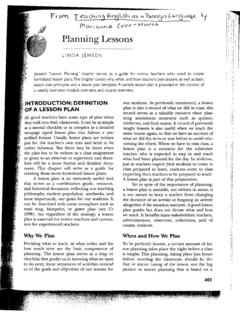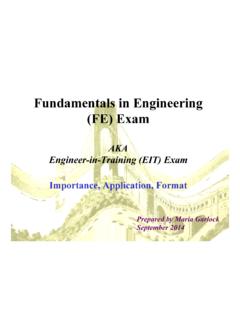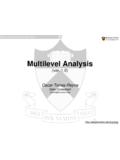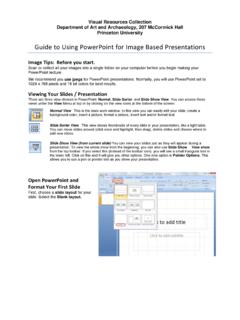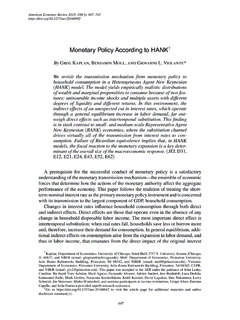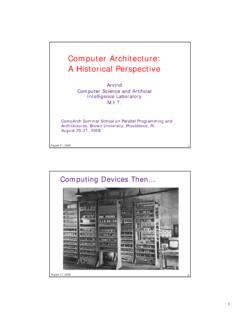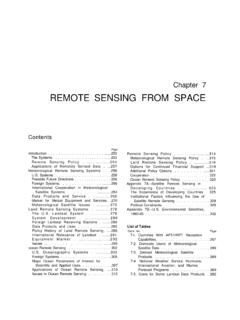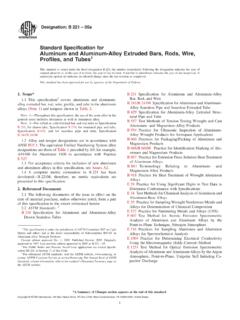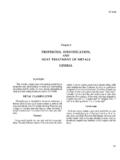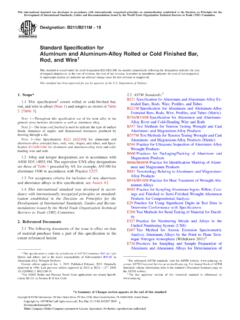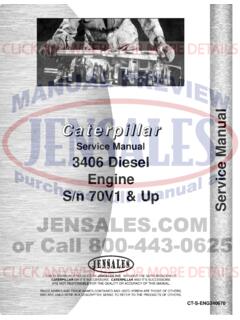Transcription of Chapter 4 Metal Matrix Composites - Princeton University
1 Chapter 4 Metal Matrix .. **n * Current Applications and Market Opportunities ..Longer Term .. l ..Research and Development Priorities ..Introduction l l l l l l l l l . l . l l l l l l . l l l l l l l l l . l l l .-..Properties of Metal Matrix Composites l l l l . l l .. l .. l l .Discontinuous Reinforcement l . l ..Continuous Reinforcement l ..MMC Properties Compared to Other Structural MaterialslDesign, Processing, and Testing ..Design.. l . l l l .. l l * l l * l l l .. Processing. l .. * .. l l .. l l . l l l .. l Costs. l .. l l .. l , l .. l l l l l l ..Testing . l l .. l l .. l .. l l l l l lHealth and Safety .. l ..Current Applications ..Future Applications ..Markets. l .. l .. l ..Research and Development Priories ..Very ..Important ..Desirable.
2 Tables,.., .*..**..*.. ,.,..*.*..l *..*..99..99.. l ..99..99..100..100..100..102.. l*..107..,.. l ..107..110.. l ..111..112..112..115l 115..116..117 Table Costs of a Representative Sample of MMC Reinforcements..1014-2. Structural Properties of Representative MMCs, Compared to OtherMaterials ..1034-3. Strength and Stiffness of Some Fiber-Reinforced MMCs..104 4-4. Properties of 6061 aluminum Reinforced With Silicon Carbide Particulate .1054-5. MMC Manufacturing Methods .. * ..1084-6. Selected MMC Processing Techniques and Their Characteristics ..109iChapter 4 Metal Matrix CompositesFINDINGSM etal Matrix Composites (MMCs) usually con-sist of a low-density Metal , such as aluminum ormagnesium, reinforced with particulate or fibersof a ceramic material, such as silicon carbide orgraphite. Compared with unreinforced metals,MMCs offer higher specific strength and stiffness,higher operating temperature, and greater wearresistance, as well as the opportunity to tailorthese properties for a particular , MMCs also have some disadvantagescompared with metals.
3 Chief among these are thehigher cost of fabrication for high-performanceMMCs, and lower ductility and toughness. Pres-ently, MMCs tend to cluster around two extremetypes. One consists of very high performancecomposites reinforced with expensive continu-ous fibers and requiring expensive processingmethods. The other consists of relatively low-costand low-performance Composites reinforced withrelatively inexpensive particulate or fibers. Thecost of the first type is too high for any but mili-tary or space applications, whereas the cost/ben-efit advantages of the second type over unrein-forced Metal alloys remain in Applications and MarketOpportunitiesCurrent markets for MMCs are primarily in mil-itary and aerospace applications. ExperimentalMMC components have been developed for usein aircraft, satellites, jet engines, missiles, and theNational Aeronautics and Space Administration(NASA) space shuttle.
4 The first production appli-cation of a particulate-reinforced MMC in theUnited States is a set of covers for a missile guid-ance most important commercial application todate is the MMC diesel engine piston made byToyota. This composite piston offers better wearresistance and high-temperature strength than thecast iron piston it replaced. It is estimated that300,000 such pistons are produced and sold inJapan annually. This development is very impor-tant because it demonstrates that MMCs are atleast not prohibitively expensive for a very costsensitive application. Other commercial applica-tions include cutting tools and Term ApplicationsMetal Matrix Composites with high specific stiff-ness and strength could be used in applicationsin which saving weight is an important factor. In-cluded in this category are robots, high-speed ma-chinery, and high-speed rotating shafts for shipsor land vehicles.
5 Good wear resistance, alongwith high specific strength, also favors MMC usein automotive engine and brake parts. Tailorablecoefficient of thermal expansion and thermal con-ductivity make them good candidates for lasers,precision machinery, and electronic , the current level of development ef-fort appears to be inadequate to bring about com-mercialization of any of these in the next 5 years,with the possible exception of diesel on information now in the public do-main, the following military applications forMMCs appear attractive: high-temperature fighteraircraft engines and structures; high-temperaturemissile structures; and spacecraft structures. Test-ing of a National Aerospace Plane (NASP) pro-totype is scheduled for the early to mid 1990s,which might be too early to include MMCs.
6 How-ever, it may be possible to incorporate MMCs inthe structure or engines of the production and Development PrioritiesMMCs are just beginning to be used in produc-tion applications. In order to make present ma-terials more commercially attractive, and to de-99100 . Advanced Materials by Designvelop better materials, the following research anddevelopment priorities should receive attention:l Cheaper Processes: To develop low-cost,lhighly reliable manufacturing processes, re-search should concentrate on optimizingand evaluating processes such as plasmaspraying, powder metallurgy processes,modified casting techniques, liquid Metal in-filtration and diffusion Cheaper Materials: Development of Iowercost fiber reinforcements is a major development work on existingmaterials is important to lower costs as.
7 Research in the area of reinforce-ment/ Matrix interface coatings is coatings can prevent deleterious chem-ical reactions between Matrix and reinforce-ment which weaken the composite , particu-larly at high temperature, and optimize theinterracial fiber/ Matrix Matrix Composites (MMCs) generallyin dramatic improvements in MMC properties,consist of lightweight Metal alloys of aluminum ,but costs remain high. Continuously and discon-magnesium, or titanium, reinforced with ceramictinuously reinforced MMCs have very differentparticulate, whiskers, or The reinforce-applications,and will be treated separatelyment is very important because it determines thethroughout this properties, cost, and performance ofTailorability is a key advantage of all types ofa given , but is particularly so in the case ofComposites reinforced with particulate (dis-MMCs.)
8 MMCs can be designed to fulfill require-continuous types of reinforcement) can havements that no other materials, including other ad-costs comparable to unreinforced metals, withvanced materials, can achieve. There are a num-significantly better hardness, and somewhat bet-ber of niche applications in aerospace structurester stiffness and strength. Continuous reinforce-and electronics that capitalize on this (long fiber or wire reinforcement) can resultPROPERTIES OF Metal Matrix COMPOSITEST here are considerable differences in publishedproperty data for MMCs. This is partly due to thefact that there are no industry standards forMMCs, as there are for metals. Reinforcementsand Composites are typically made by proprie-tary processes, and, as a consequence, the prop-erties of materials having the same nominal com-position can be radically different.
9 The issue isfurther clouded by the fact that many reinforce-ments and MMCs are still in the developmentalstage, and are continually being refined. Numer-ous test methods are used throughout the indus-try, and it is widely recognized that this is a ma-jor source of differences in reported As used i n this Chapter , the terms 1 al u m inu m, magnesium, and titanium denote alloys of these materials used as matrixmetals.~Carl Zweben, Metal Matrix Composites , contractor report forOTA, January data given in this Chapter are thereforegiven as ranges rather than as single MMC properties cannot be measured asthey would be for monolithic metals. For in-stance, toughness is an important but hard-to-define material property. Standard fracture me-chanics tests and analytical methods for metalsare based on the assumption of self-similar crackextension; , a crack will simply lengthen with-out changing shape.
10 Composites , however, arenon homogeneous materials with complex inter-nal damage patterns. As a result, the applicabil-ity of conventional fracture mechanics to MMCsis controversial, especially for fiber-reinforced ma-terials. Ch. 4 Metal Matrix Composites l 101 Photo credit: DWA composite Specialties, (75x magnification) of 20 percent volumefraction silicon carbide particulate-reinforced2124 ReinforcementThere are two types of discontinuous reinforce-ment for MMCs: particulate and whiskers. Themost common types of particulate are alumina,boron carbide, silicon carbide, titanium carbide,and tungsten carbide. The most common typeof whisker is silicon carbide, but whiskers of alu-mina and silicon nitride have also been generally cost more than particulate,as seen in table 4-1.


